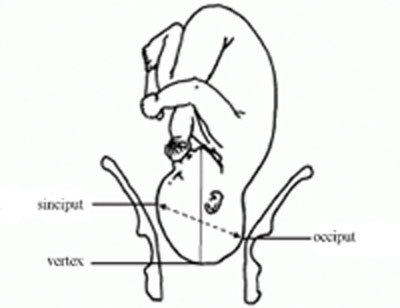Vertex presentation
In about 95% of deliveries, the part of the fetus which arrives first at the mother's pelvic brim is the highest part of the fetal head, which is called the vertex (Figure 8.1). This presentation is called the vertex presentation. Notice that the baby's chin is tucked down towards its chest, so that the vertex is the leading part entering the mother's pelvis. The baby's head is said to be 'well-flexed' in this position.

During early pregnancy, the baby is the other way up — with its bottom pointing down towards the mother's cervix — which is called the breech presentation. This is because during its early development, the head of the fetus is bigger than its buttocks; so in the majority of cases, the head occupies the widest cavity, i.e. the fundus (rounded top) of the uterus. As the fetus grows larger, the buttocks become bigger than the head and the baby spontaneously reverses its position, so its buttocks occupy the fundus. In short, in early pregnancy, the majority of fetuses are in the breech presentation and later in pregnancy most of them make a spontaneous transition to the vertex presentation.